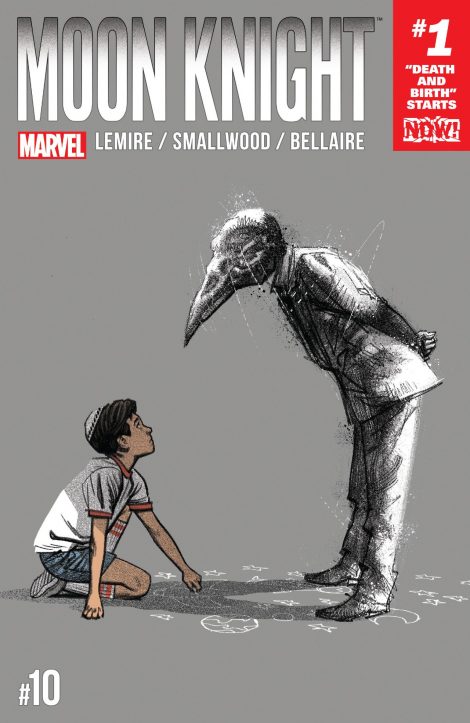A light week as we try to get back into the swing of things after the holidays! Jackson explores what makes this run of Moon Knight from Marvel Comics so compelling compared to past takes.
Want to hear more about what we thought about these issues? Read on – and let us know what you thought in the comments below.
Jackson’s Reads
Moon Knight #10

Author: Jeff Lemire
Artist: Greg Smallwood
Publisher: Marvel Comics
★★★★☆
There are few characters Marvel has tried harder with less success to sell than Moon Knight. The character’s standout stories, Bill Sienkiewicz’ landmark artistic debut, as well as Warren Ellis and Declan Shalvey’s bone-rattling fight comic, are vastly overshadowed by the legions of frankly disastrous stories, like Charlie Huston’s violent ‘90s-esque thriller or Brian Michael Bendis’ naive, pandering treatise on mental illness and super heroics. With so many creators trying so many times to make Moon Knight work, the character’s never had a very consistent set of features or sense of identity with only, somewhat ironically, his fractured sense of self remaining across incarnations.
It’s this sense of a shattered identity that Jeff Lemire has latched onto with his run. With art by Greg Smallwood, as well as a host of other pencillers during the second arc, this is a run that explores who Moon Knight really is and who exactly it is under the mask.
It’s a high concept question buried under an equally high concept presentation. Lemire’s Moon Knight run plays with the interaction between Marc Spector and the family he’s constructed, both Khonshu as well as the imaginary friends his mind has made manifest, as well as the people who ultimately come to depend on him.
After the first two arcs, Moon Knight #10 is the first issue to really address the premise explicitly, by showing Marc’s early years constructing his own world as well as his current struggle against his god and father figure and the consequences the construction of his self-image has had on others.
It’s a high wire balancing act of a comic, more interesting to analyze than enjoyable to read. It’s a fascinating way to balance Spector’s diagnosis as a functioning individual who turns to super heroics to survive multiple personality disorder with analyzing him as a flawed man whose choice to fight mental illness by engaging in violence actively harms those he claims to protect. That’s a heady, interesting criticism of not-only the book’s protagonist but superheroes as a whole but it’s buried in opaque dialogue and a host of writerly bits of sleight of hand that holds readers off from actively getting to see how this comic works.
The art, however, brings a human sense of passion as well as mythological horror to the issue. Smallwood art’s legitimately never been better, which is saying something. His work over the last three years at Marvel has been quietly majestic, bringing Shalvey’s punk-violent style to something more cartoonish and elegant with stunning, creative layouts, like when Moon Knight passes through the world of the living into the realm of the dead.
Moon Knight #10 is the best issue of Lemire and Smallwood’s run so far because it grounds its complicated, compromised hero in an approachable story of mental illness and questions of identity while showcasing the psychedelic mythology that’s dominated interpretations of the character for the last 5 years. It’s a smart story but a demanding one, not willing to cede answers and requiring readers to project their own beliefs and thoughts on mental illness onto it. Perhaps that’s a conscious choice and this is a storyline that still has time to make a statement but readers should know what they’re getting into before pulling Moon Knight #10 off the shelf.

